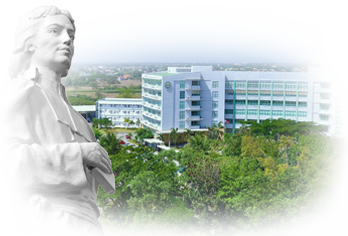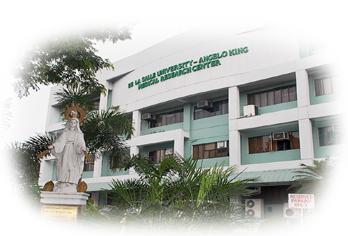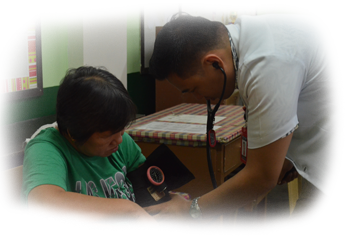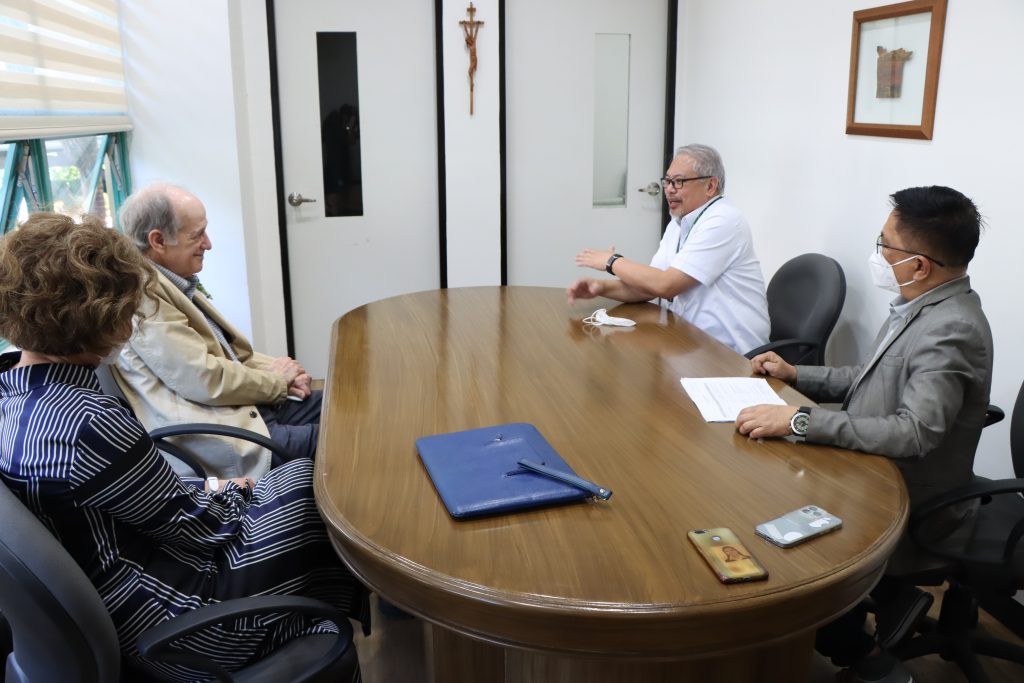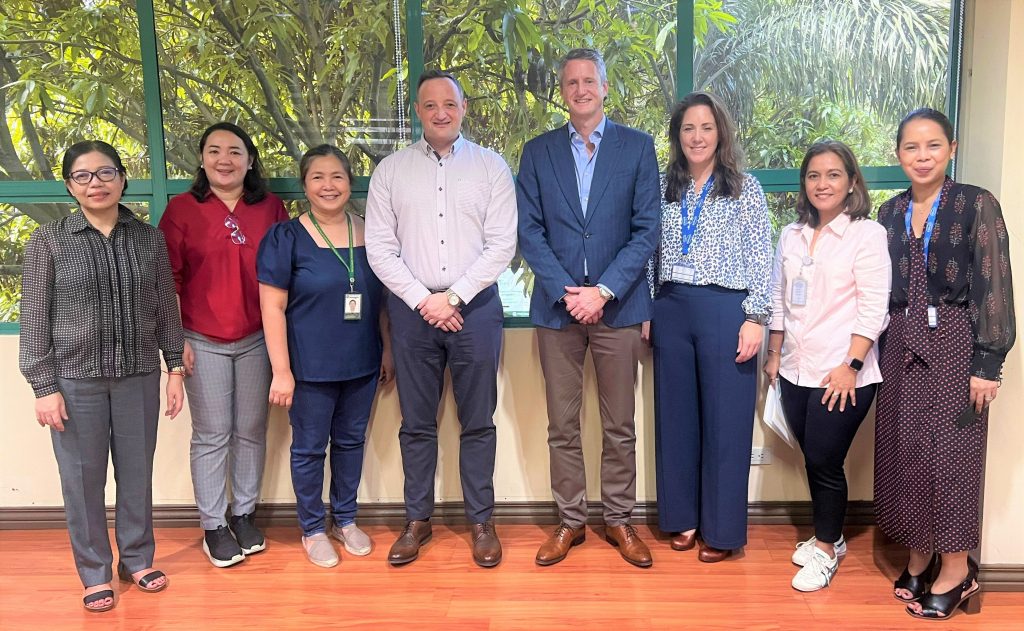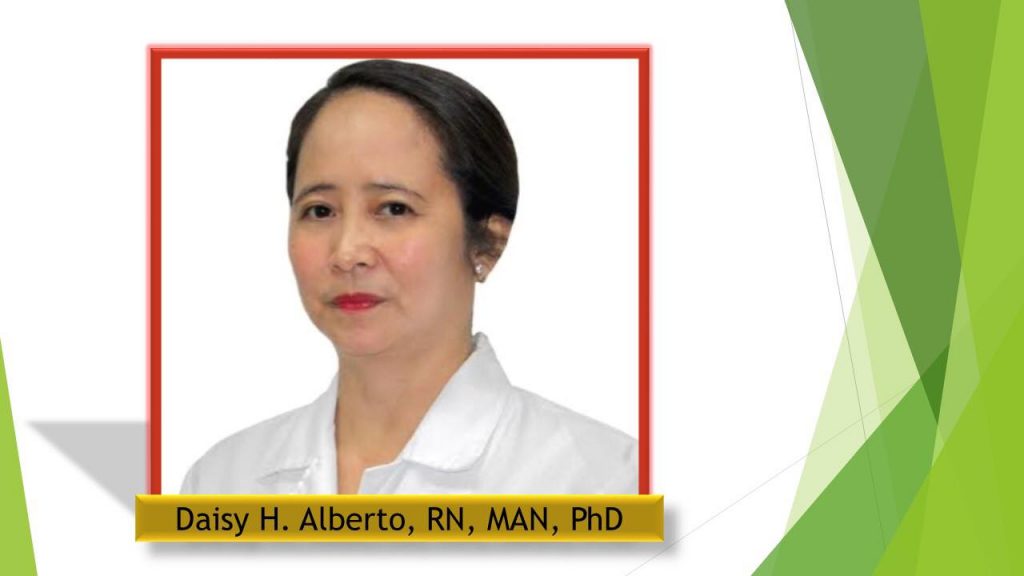
- Cavite line: (+6346) 481-8000 |
- Manila line: (+632) 8988-3100 | Supplier's Corner | Go to MyDLSMHSI | Privacy Policy |
Exploring indirect impacts of COVID-19 on local health systems from the perspectives of health workers and higher education stakeholders in the Philippines using a phenomenological approach
September 21, 2022 | 4:41 pm

Exploring indirect impacts of COVID
Joemer Maravilla, PhD*1,2,3,6, Jayson Catiwa, MN*1,4,7, Rebecca Guariño, MAN2, John Federick Yap, PhD1,5, Celso Pagatpatan, Jr., DrPH2, Diana Dalisay Orolfo, MPH2, Jeriel de Silos, MD2, Ma. Cynthia Leigh, PhD1,5, Jerome Babate, MBA1, and Violeta Lopez, PhD1,8
1Filipino Nursing Diaspora Network, Australia
2Graduate Studies in Medical and Health Sciences, De La Salle Medical and Health Sciences Institute, Philippines
3Institute for Social Science Research, The University of Queensland, Australia
4Southeastern Sydney Local Health District, New South Wales Health, Australia
5School of Nursing and Allied Medical Sciences, Holy Angel University, Philippines
6Institute of Nursing, Far Eastern University, Philippines
7The George Institute for Global Health, University of New South Wales, Australia
8School of Nursing, Midwifery and Social Sciences, Central Queensland University, Australia
*Joint first authors
Corresponding author:
Jayson Catiwa, MN
Director, Filipino Nursing Diaspora Network
healthcoveproject@findnetwork.org
+61 449 868 824
Abstract
Background
Our study aimed to describe experiences and perspectives of stakeholders from local government units, health facilities and health professional education institutions on the delivery of non-COVID-19 health services after the initial wave of the pandemic.
Methods
A total of 29 public health workers, 13 university staff, and four hospital administrators in the Philippines participated. Using a descriptive phenomenological approach, we analysed transcripts from six focus group discussions conducted online between March 2021 to June 2021.
Findings
Thematic analysis suggests that the COVID-19 pandemic has left routine health programs inaccessible due to hesitancy among patients to visit health facilities, a shift in public health priorities, and lack of students to augment the existing workforce.
Public health workers reported stress and mental health exhaustion. Apart from fear of infection during service provision, public health workers and university staff highlighted work overload, pressure to learn new technology, and webinar fatigue. Mental health problems have surfaced as health workers and young people have become more affected while support services remain insufficient.
Public health workers and hospital administrators have reported actions of resilience to maintain service delivery such as workforce capacity building and management and use of telehealth. However, issues on workforce wellbeing and digital equity posed adaptation challenges. Participants also perceived partnership with higher education institutions as pivotal to position local health systems towards recovery.
Interpretation
The rapid change in the service landscape highlights the importance of sustainable partnerships, effective workforce management, equitable digital innovations, and promoting mental wellbeing to preserve community, school, and occupational health and rebuild resilient local health systems particularly in low-resourced areas.
Keywords: local health systems; service delivery; COVID-19; pandemic; Philippines
Funding
This research is proudly supported by the Australia-ASEAN Council, Australian Government Department of Foreign Affairs and Trade.
Introduction
The COVID-19 pandemic has greatly impacted various aspects of health systems particularly in the delivery of routine public health services, such as immunization, family planning, and maternal care.1 It was anticipated that the decline in the provision of reproductive health and child health services may result into at least 12,000 increase in maternal death and 250,000 in child mortality in low- and middle-income countries (LMICs).2
In the Philippines, an extreme drop in prenatal visits, utilization of treatment for tuberculosis and consultations for hypertension was observed a year after the pandemic started.3 Social distancing restrictions resulted in fewer paediatric consults among the under-5 population.3 Routine vaccinations for children has also been delayed due to stock issues and the inability of health workers to implement pre-pandemic strategies such as mass campaigns and home visitations.4 Significant changes in health workforce priorities also led to a decline in the delivery of routine public health services.5
While the evidence pointed to reduced service delivery, current research failed to further characterise adaptive mechanisms to meet health demands of sub-national or local health systems. Local health systems may not only include hospitals and primary health facilities but also higher education institutions, which have a critical role in training future health professionals and producing innovations to strengthen health systems. A recent review, while have had presented rigorous data on service uptake, focused on hospital admissions and presentations in emergency departments1 which may not reflect the system-wide situation. A pulse survey by the World Health Organization during the early stages of the pandemic provided details on fragmented health service delivery of routine health programs but showed limited perspectives from local or community stakeholders.6 Considering inputs from local-level stakeholders are main paramount, especially for countries like the Philippines with devolved health systems.
Global analyses highlighted country-level strategic initiatives and modifications to service delivery to address the immediate effects of COVID-19-associated disruptions in health service.7, 8 However, it is not clear how these innovations align with the maintenance of non-COVID-19 health services at subnational or local levels. The underrepresentation of LMICs in these reports skews the findings to countries with good access to resources and technology.7, 8 Investigating social landscapes and experiences of LMICs such the Philippines without existing mechanisms for ensuring continuity of non-COVID-19 primary health services may provide insights on how current innovations can be best adapted in these challenging environments.9
This study aimed to explore the perspectives of local health service providers and managers on the indirect impacts of the pandemic on health systems to maintain the delivery of routine public health services. We also investigated viewpoints from health professional education institutions (i.e., universities) with existing partnerships with local government units, which allowed us to integrate experiences from the poorly studied areas of occupational health during the pandemic.
Methods
Study design and participants
The study applied a descriptive phenomenological design to explore the experiences of local stakeholders and their perspectives about local health systems. This approach in phenomenology allowed the study describe participants’ experiences while excluding researchers’ presupposition to enable objectivity of the interpretation and improve the validity of the themes identified. We also used a participatory approach by involving selected participants in sample recruitment, analysis, and translation during program design.
This phenomenological research is a sub-study of a participatory action research (PAR) by the Filipino Nursing Diaspora Network, an international professional organization of Filipino nurses. This PAR aims to design, implement, and evaluate a virtual capacity building program to assist local health systems in the Philippines.10
Using purposive and snowball sampling, this PAR has five health professional education institutions (i.e., nursing, and public health schools) with an existing partnership with at least one local government unit (LGU) (i.e., city or municipality) through their respective public health office (i.e., university-LGU dyad). Managers and staff involved in program implementation and service provision such as physician, nurses, and midwives, were invited to participate. Apart from their respective deans or heads of nursing schools, universities were asked to delegate at least two faculty members involved in community extension activities and/or student clinical placements.
Five university-LGU dyads in the study comprised of three from Luzon, one from Visayas, and one from Mindanao, which are the Philippines’ main island groups (or regions).
Data collection
Semi-structured focus group discussions (n=6) were conducted online between March 2021 to June 2021. Generally, one group session was allocated for each dyad except for Mindanao. However, participants from the Mindanao dyad were divided into two groups to maintain a manageable group size. We held one focus group per dyad to gain multiple perspectives on discussion questions by allowing exchanges of thoughts, ideas, and personal realities within and between participants from education institutions and public health offices.
Each focus group (with 6 – 10 participants) was run by one skilled facilitator and two note-takers between 74 – 90 minutes. The facilitator asked questions and primarily engaged in the dialogue with the group while the note-takers documented important verbal and non-verbal (if any) cues and video recorded each focus group. All focus group discussions were conducted in English or in Filipino language. Open-ended questions were asked such as “what are the health challenges that your community has encountered in light of the COVID-19”; “what common/usual health programs implemented were affected during the pandemic”; “what new strategies did you implement to cope with these impacts”. Probing questions were used to explore in-depth issues that were highlighted by the majority of the participants or were unique.
With participants’ consent, all sessions were video recorded and stored in a password-protected cloud. Stored in the same cloud, participant name, main affiliation, role and designation and contact number were asked to facilitate reimbursements. Only four investigators (JM, JC, RG, and JFY) have access to the cloud.
Analysis
Note takers transcribed the discussions verbatim and de-identified each session. All investigators are fluent in English and Filipino language; hence, transcripts were not translated during analysis.
Using an inductive analytical approach, we identified patterns or themes within the data without an researchers’ preconceptions or a priori coding framework.11 After each session, assigned facilitator and note takers discussed initial codes that emerged from the discussion.11 Four analysts (JM, RB, JFY and VL) independently coded the transcripts for recurring themes and clusters manually. The lead investigator (JM) resolved coding biases and summarized and discussed the identified themes and clusters with all investigators for consensus. Themes and clusters in the study reflected summative perspectives rather than unique themes for each dyad and region.
Quotes highlighted in the results section were agreed by all investigators and translated to English by RG and back translated by JFY. The role and location of the participants were shown for each quote. The actual wordings were presented in the Supplemental File to provide readers better context, enable cross-cultural understanding of the results, and demonstrate the analytical rigor of this study.12
Ethics Approval
This study was approved by Holy Angel University’s Institutional Ethics Review Board (Reference: 2020-054). Written informed consent and/or recorded verbal consent were obtained from the participants before each focus group discussion. Transcripts and quotes were de-identified by showing their role (e.g., nurse, physician, program officer, academic faculty, academic manager), main affiliation (i.e., LGU, university), and location (i.e., Luzon, Visayas, Mindanao).
Results
Participant characteristics
We have a total of 42 participants, primarily from universities, and Luzon and Mindanao regions (refer to Table 1). Four participants (i.e., nursing directors and public health officer) from hospitals were snowballed and provided perspectives as referral centres for more advanced care and outpatient services.
Apart from academic managers (e.g., deans, academic/clinical placement coordinators) and staff (e.g., clinical preceptors, teaching academics), we also recruited community engagement/extension officers from three universities across all locations. Community engagement officers both coordinate community placement for students and assist in providing services in the community. Participants from LGUs include public health managers and officers who are responsible in the development and monitoring of implementation strategies for routine health programs. Service providers included rural health physicians, public health nurses, community health workers, and primarily represented two Luzon LGUs.
Emerging themes
After rigorous analyses, four major themes and 13 clusters were identified to describe the indirect impacts of the pandemic on local health systems including school health systems. As shown in Table 2, these themes were: (1) reduction in access and utilisation of routine public health programs, (2) fear and fatigue among workers, (3) increased awareness of mental health problems, and (4) demonstrated resilience.
Table 1. Participant characteristics
| Characteristics | n (%) |
| Total | 42 (100%) |
| Main Affiliation | |
| University | 25 (59.5%) |
| LGU – Public health office | 13 (31.0%) |
| Hospital | 4 (9.5%) |
| Role | |
| Academic manager | 11 (26.2%) |
| Community engagement officer (university) | 5 (11.9%) |
| Academic staff | 8 (19%) |
| Public health manager | 3 (7.1%) |
| Public health officer | 2 (4.8%) |
| Rural health physician | 4 (9.5%) |
| Public health nurse/midwife | 2 (4.8%) |
| Community health worker | 3 (7.1%) |
| Nursing director (hospital) | 3 (7.1%) |
| Social worker (university) | 1 (2.4%) |
| Region | |
| Luzon | 19 (45.2%) |
| Visayas | 5 (11.9%) |
| Mindanao | 18 (42.9%) |
| Gender | |
| Female | 29 (69.0%) |
| Male | 13 (31.0%) |
Reduction in access and utilization of routine public health programs
Reduction in access and utilization of routine public health programs was evident in participant responses in all focus groups. Affected programs include but not limited to family planning, tuberculosis treatment, child health services, and routine immunization program. In the following quotes, two of the public health managers specifically mentioned the disruption in conducting health education and advocacy activities on reproductive health and rights.
“I go to communities to conduct education seminars on women empowerment, reproductive health, gender and development, and to attend to the concerns about the programs of our city… But then, because of COVID-19, all these activities were disrupted.” (Public health manager, Mindanao)
“Our problem in (city), being in the population office… since this pandemic (is that), we were not able to go out to the community and expand our advocacy, especially our population management and adolescent health development programs.” (Public health manager, Visayas)
One of the rural health physicians shared the decline in tuberculosis detection rate within her catchment area due to curfews particularly among older population.
“For (the) NTP (National Tuberculosis Program), our detection (rate has) decreased because the senior citizens are not allowed to go out (of their homes). We were not able to identify and access consultation services.” (Rural health physician, Luzon)
This detrimental disruption of routine services is further explained through the five distinct clusters (see Table 2).
Table 2. Indirect impacts on local health systems
| Themes | Clusters |
| Reduction in access and utilization of routine public health programs | Hesitancy among patients to visit health facilities |
| Shift in priorities to COVID-19 services
|
|
| Lack of students to augment the existing workforce
|
|
| Fear and fatigue among workers | Fear of contracting COVID-19 while providing services
|
| Work overload due to staff shortage
|
|
| Stress related to use of technology
|
|
| Webinar fatigue
|
|
| Increased awareness of mental health problems | Mental health problems among workers |
| Young people being affected
|
|
| Need for accessible mental health services
|
|
| Demonstrated resilience | Increasing capability to maintain service provision
|
| Development of innovation and new approaches
|
|
| Partnership with higher education institutions |
Hesitancy among patients to visit health facilities
Service providers who are also working as academic staff stated that community members hesitate to visit community health centres/clinics due to fear of acquiring COVID-19. For example, an academic manager discussed the belief among patients that all health facilities manage patients with COVID-19.
“There is fear among patients… to actually go out to (visit) health facilities because of the misconception and perception that all facilities are COVID-19 referral …” (Academic manager, Luzon) (Academic manager, Luzon)
A clinical academic who is also working in a hospital nurse believed that visiting health facilities will make individuals exposed and suspected to be infected by the virus, which further discourage patients to seek health advice.
“If you go to hospitals, you will be considered a COVID-19 suspect. So, people don’t want to go to hospitals or clinics for check-ups.” (Academic staff – clinical preceptor, Mindanao)
Same respondent also narrated treating paediatric patients with untreated conditions; she thought that parents decided to defer seeking medical assistance due to fear of having their children exposed to the virus.
“…We noticed that they only go to hospitals when their concern is considered an emergency. They will only bring their children with very high fever for several days, with difficulty of breathing, or when there are episodes of seizures… There is prolonged cough, but they did not go to the hospital because they are afraid of being (exposed) in the hospital.” (Academic staff – clinical preceptor, Mindanao)
A community engagement officer of a university, who work closely with rural health centres, believed that patients prefer for health workers to provide services through house visitations, but health facilities are short-staffed to deliver routine health services directly to households.
“People preferred house-to-house services. They don’t want to go out; they don’t want to go to the (health) centres because of COVID-19.” (Community engagement officer, Mindanao)
Shift in priorities to COVID-19 services
A drastic shift in service delivery priorities was noted during discussions. A public health manager and rural health nurse stated that their involvement in providing COVID-19 services such as contact tracing made non-COVID-19 patients with needed care and services not prioritized.
“How to respond to COVID-19… I became a contact tracer, which became my main role… in terms of (routine public health) programs, they were left out.” (Public health manager, Mindanao)
The rural health physician and nurse of a municipality in Luzon also mentioned that the procurement of commodities such as contraceptives and other medicines were overlooked as their local government unit prioritised the distribution of test kits and COVID-19 vaccines particularly in remote communities like theirs.
“There is shift in focus… because of the emerging COVID-19 cases in (municipality). And then the procurement (for other health programs was affected), …that’s why there’s a big adjustment.” (Public health nurse, Luzon)
“The delivery of all the commodities were delayed.” (Rural health physician, Luzon)
Clinical preceptors in an outpatient hospital clinic and urban health centre in Mindanao attributed the increase in uncontrolled cases of chronic diseases such as hypertension and type II diabetes mellitus to the disruption in education and counselling programs. One mentioned that patients who rely on free services and consultations from public health facilities were not able to get prescriptions and refill their medications to maintain normal blood pressure and blood sugar.
“…and what happened is that most of the patients who rely on services or programs (non-COVID-19 services) …if they have questions like how to administer insulin, … diet plan…which are common for senior citizens. These services are gone. Most of them (patients) have difficulty in accessing services and most of them, when they come back (to the clinic) for check-up, they already have uncontrolled diabetes, uncontrolled hypertension…” (Academic staff – clinical preceptor, Mindanao)
The other also highlighted that the health centres which he is affiliated with needed to postpone education/ promotion activities which were normally done in person, due to social distancing restrictions.
“There are weekly gatherings, free BP (blood pressure) and blood sugar measurement, and then there are health education programs or health teaching programs… this is pre-COVID… but these types of services are suddenly not available.” (Academic staff – clinical preceptor, Mindanao)
Lack of students to augment the existing workforce
Students and trainees are a large part of the health workforce both in hospital and community contexts. However, the risk of infection made universities to stop work placements. An academic and clinical coordinator expressed her inhibitions to deploy students for community activities.
“It’s impossible for students… to implement health programs due to safety concerns.” (Academic manager – academic and clinical coordinator, Luzon)
National policies governing higher education institutions have also put strong recommendations to postpone clinical and community placements. One of the deans mentioned that their university, in response to national recommendations, decided to delay student placements until further advise is received from the national government.
“…the school will not take responsibility to look after the students to be deployed for (clinical placement) activities.” (Academic manager – dean, Luzon)
Fear and fatigue among workers
The health workforce plays a huge part in maintaining a functional health system during pandemic. However, the pressure to minimize service delivery disruptions and achieve program targets have caused health workers to experience mental exhaustion. We identified four clusters that further explain this theme (see Table 2).
Fear of contracting COVID-19 while providing services
Respondents who are also public health workers have expressed their concern about their safety and of their families. They are worried about acquiring COVID-19 while interacting with patients and community members.
“Of course, even health workers are afraid of contracting COVID-19… There have been a lot of healthcare workers who have already tested positive.” (Public health manager, Luzon)
“…it came to a point when health workers were afraid to report for work… however, we are not allowed to go on lockdown because we are frontliners.” (Public health officer, Mindanao)
“… Catering to our clients in person becomes a traumatic experience because of the uncertainties whether or not the patient has COVID-19.” (Public health manager, Visayas)
Work overload due to staff shortage
The demand for health services while managing COVID-19 related activities has caused health workers to take on more roles beyond their capacity. A rural health physician and a public health manager highlighted that the pandemic has worsened the existing workforce issues of having multiple roles including administrative tasks, and clerical responsibilities.
“There are overlapping responsibilities especially on my part. There are two nurses here, and I am more senior hence everything is my responsibility. We lack sleep and food… We are overloaded to cope with reports.” (Rural health physician, Luzon)
“Some of the BHWs (community health workers) became members of BHERTs (Barangay Health Emergency Response Teams for COVID-19). Some cannot cope with work. What causes the stress is the multitasking.” (Public health manager, Visayas)
Despite the high job demands, several health workers still chose to remain working due to their unwavering commitment to serve the community. A community engagement officer of a university shared the dedication of wife to her work as a clinical nurse.
“My wife is a frontliner. There is a huge chance that she is exposed and might cause transmission at home. When the cases increased, there lack of PPEs. I asked my spouse if it’s possible for her to resign. But since it’s her call of duty, she decided to stay to work because of lack of manpower …” (Community engagement officer, Luzon)
Stress related to use of technology
Most of the respondents mentioned the need to learn how to use online platforms for videoconferences and other online events (e.g., training, workshops, meetings). Patient consultations and health education sessions have been done remotely due to social distancing. This work model required more frequent use of applications and devices, which not all participants were willing to be trained. An academic manager mentioned her intention to retire due to the stress of learning new technology not only for teaching but also in service provision.
“I don’t want to face technology because I am not used to it. So, it would be better for me to retire, over experiencing another crisis in my life. I am waiting for my sun to set down, and you know, here comes the virtual environment. So, they prefer to retire over adjusting to the change and adapt…” (Academic manager, Visayas)
Another academic manager shared their experience in conducting online training programs for community leaders. She believed that use of online platforms has contributed to mental strain among health worker especially those who perceived these platforms as ‘complicated’ to use.
“We also have training programs in the community. It adds to the mental health concerns of the people (health workers), our training programs are online and not all people are techno-savvy.” (Academic manager, Mindanao)
Webinar fatigue
Health workers were required to attend several mandatory training and seminars during the pandemic. A public health midwife described her and colleagues’ experience attending consecutive webinars daily in addition to her role in providing patient care, which she thought was exhausting. She also mentioned instances of attending simultaneous webinars using multiple devices to comply with training requirements and attend engagement meetings with community stakeholders.
“…frantic with webinars. There are more webinars… Webinars are being done simultaneously. So aside from health services, we are exhausted because of webinars. If we were not able to join right away, we are being called (via telephone/ mobile). Doing our work and submitting our reports are done at the same time. Basically, the health workers are tired because of the paper works and webinars.” (Public health midwife, Luzon)
The increase in their screen time and pressure to multi-task were perceived by respondents as a major factor for mental exhaustion among health workers. Two academic managers mentioned their staff experiencing burnout and difficulty managing their activities.
“…there are those who complained because they are experiencing burnout. I guess Zoom (online video conference application) fatigue is true… It is very tiring.” (Academic staff – clinical preceptor, Luzon)
“The disadvantage (of webinars), overlapping, same schedule with classes. Then there’s a meeting and a webinar at the same time. Time management is the most difficult.” (Academic manager, Luzon)
Increased awareness of mental health problems
Mental health issues in the community were believed to escalate during the pandemic (see Table 2). A dean from a health sciences school believed that the pandemic affected mental health of individuals including those who they have been infected, those who have survived and those who never acquired the virus.
“This pandemic spared no one. Even if you were spared from physical effects ng COVID-19, you are not spared from mental health (problems) or the varying levels of emotions. Others are manifesting mental health (problems), those beyond normal manifestations. Others are coping well but they recognized that they are suffering also. As I have said, no one is spared.” (Academic manager – dean, Luzon)
Mental health problems have surfaced as a public health concern and are now seen as a priority in medical training according to a clinical preceptor on community medicine.
“About mental health, there is a big paradigm shift. It is only recently that it is being focused on, during my medical school days it is not emphasized. It is only now that I encounter this that I needed to be sent for training.” (Academic staff – clinical preceptor, Luzon)
As outlined in Table 2, participants described health workers and young people to be mainly affected (i.e., first two clusters). Participants also highlighted the need for accessible mental health services (i.e., third cluster).
Mental health problems among health workers
Some participants including those infected by COVID-19, reported to have a lived experience of mental health problems since the pandemic. A public health manager mentioned her experience with anxiety and depression during the pandemic.
“I, myself, I have anxiety, I suffered from depression and started treatment already. I am under treatment; I am taking medications. You will see, it’s not only me but there are many… even in other companies, in other sectors… I am not giving enough time for myself. I have anxiety.” (Public health manager, Luzon)
A community engagement officer believed that mental health problems arose from work overload and burnout.
“…because of the rising cases and being understaffed, some are overworked health care workers. This situation predisposed them to mental health issues.” (Community engagement officer, Visayas)
Young people being affected
Participants from the university sector raised their concerns about young people’s mental health particularly among students. One academic manager noted that young people were particularly affected due to sudden shift to online learning.
“…mental health problems among young people because of all the challenges they have; they have to adjust to so many things online …at the same time the shift caused anxiety, the shift in the educational system, because in online education they were given more responsibility in their studies. Yes, it seems that the ‘supposed to be in school feeling’ is gone, because they have to proceed on their own, at their own pace, so it adds to the mental health concern.” (Academic manager, Mindanao)
A social worker added that the abrupt changes in social environment affected students’ coping particularly during community lockdowns.
“We have students adjusting with the new normal, not having the online class, being away from their families, being away from (city), some are not from (city).” (Social worker, Mindanao)
Other academic mangers also highlighted the influence on mental health of adverse socio-economic shift among students and their families.
“…their parents were not able to continue their family livelihood following the lockdowns… others are experiencing recession; their parents have to go back to their province and left with… nothing in terms of their income. That indirectly affects our students because they can no longer sustain… their studies, although we say that they are in the comforts of their home, but they do not have the (social) connection as that of before.” (Academic manager, Visayas)
“Of course, indirectly because the loss of income adds to the mental health concerns; other members of the family lost their jobs and businesses are not earning.” (Academic manager, Mindanao)
Immediate responses to assist young people
Some universities have initiated immediate responses due to the abrupt increase in demand for mental health services and programs for students. For example, a university in Mindanao providing remote counselling and psychological first aid.
“We have this united registered social worker (organization) in which we provided telephone and online psychosocial first aid for those who have mental health problems because they (students and university staff) became depressed because of the pandemic.” (Social worker, Mindanao)
The university also encouraged students to participate in different promotion activities including digital journaling and mental health webinars. They also provided students with two- to three-day study breaks in the middle of a semester which they consider as “mental health breaks”.
“We allowed our students to have some digital journaling… expressing their feelings to help them in their mental health. Apart from that, I think it was already mentioned the efforts done by the university to conduct (by conducting) webinars.” (Academic staff – clinical preceptor, Mindanao)
“So, the whole November and December, we have a mental health break for the students.” (Academic manager, Mindanao)
Need for accessible mental health services
Having the abovementioned observations in the community and workplace, as well as having lived experience, participants recommended more accessible mental health services and programs.
“I just envisioned… family healing or community healing, what we can do about it. Of course, we need to look who have a lot of issues… especially emotional and psychological issues.” (Public health manager, Mindanao)
“They need mental health programs that will provide debriefing and lessen the stress at work.” (Academic staff – clinical preceptor and practicing public health physician, Luzon)
Demonstrated resilience
Increasing capability to maintain service provision
Several public health managers mentioned providing staff training on infection control to enable health workers to continue with service provision and prevent COVID-19 transmission. Other service providers with low patient loads were trained on other skills like psychological counselling. A clinical preceptor mentioned that city health dentists in some communities were trained and deployed to provide psychological counselling.
“They mobilized the city dentists to become mental health counsellors for those who are in quarantine. They don’t have dental cases to manage… For them to be productive, their duties were shifted to do counselling (for) post-quarantine and post-isolation (patients).” (Academic staff – clinical preceptor and practicing public health physician, Luzon)
One rural health physician said that their staff who were initially deployed to provide COVID-19 services were gradually re-assigned to their usual role of providing routine public health services.
“What we did is that we deployed our staff in their (usual) area so that consultation can be done, and attention can be given to the programs.” (Rural health physician, Luzon)
Development of innovation and new approaches
“The important thing is that we learned, and we adapt, and we make changes or strategies in order to correct or to avoid that in the future.” (Community engagement officer, Visayas)
Telehealth services
The use of telehealth was noted as the most common and newly implemented service delivery approach particularly by hospitals. For example, online consultations allowed patients to send photos to facilitate physical examination.
“What we did is that the midwife will call and inform the doctor. If there are skin lesions, they will take a picture then it will be forwarded through messenger, then we will have telemedicine (teleconsultation).” (Rural health physician, Luzon)
A practicing pharmacist mentioned pharmacies providing online and mobile services which enable patients to refill their medications. attend health education sessions, counselling, and physical examinations.
“I just wanted to add the context from community pharmacies. We have here an RHU (rural health unit) (where) we also do tele pharmacy. There are also several pharmacies and localities that do tele pharmacy… online counselling then the medicines will be delivered, and prescription will be provided.” (Academic manager and practicing pharmacist, Luzon)
While telehealth was deemed to be the ideal approach to facilitate access to health services, other public health units encountered issues with connectivity especially among those in remote communities and those with low socioeconomic background.
“There are municipalities that were given training in telemedicine. But for us, internet connection is difficult. Although all barangays should have but when communicating with the field staff, there is difficult internet connection.” (Rural health physician, Luzon)
“Regarding technology, there are problems like those who cannot afford to buy (an) Android phone. So even if we conduct this, they will not be able to get the (health) information.” (Public health manager, Visayas)
“So, for our pre-marriage counselling, we made a solution through webinars, but the problem is the signal… some don’t have mobile phone… For those who lives far, they don’t have internet signal…” (Public health officer, Visayas)
Home delivery of medications
Other public health units have maintained access to medications including contraceptives through home deliveries especially during community lockdown. A public health manager mentioned that they ask community health workers to deliver medications such as contraceptive pills and anti-retroviral directly to households.
“And for the family planning (program), what we did if they cannot come especially the current users, we delivered their contraceptive pills. And even the health workers, even if they are senior citizens, they did not stop serving the community. We have like Grab (delivery company) for 6 months wherein we delivered the ARVs (anti-retroviral medicines) to our clients.” (Public health manager, Luzon)
Use of social media to disseminate health messages
Others have implemented social media strategies to educate the community and disseminate health information using audio-visual materials. A city health office in Visayas created their official Facebook page to deliver health promotion activities particularly for young people.
“On our Facebook account, we posted videos, created by our academic partners here in (city), for our adolescent health development program. We did that to disseminate the message that we really wanted to tell them… They will be encouraged because the videos on teenage pregnancy and risky behaviours were mostly produced by and with high school students…” (Public health manager, Visayas)
A university with ongoing community engagement programs utilised traditional forms of media to disseminate health information.
“We also have a local radio station and local newspaper. We also have cable (TV channel) and a partnership with (non-government organization). We used those as venues to disseminate information; we have a radio slot monthly about health that continues.” (Academic manager, Luzon)
Partnership with higher education institutions
Respondents from universities described their current partnership with the local government to facilitate information exchange and capacity building during the pandemic. A manager from a nursing school mentioned their training initiative with a public high school which caters both students and teachers.
“We (did) it already with our public school health program where the university invites various resource persons from various schools and departments to (conduct) capacity building activities to public school teachers and students.” (Academic manager and nurse practitioner, Luzon)
Academic respondents also highlighted the importance of research to that address actual practice gaps in the community.
“But if there’s research, hopefully those practical problems will be good research (projects) for students… the results can be applied in rural health units… Although, I know it is important to have theoretical (work); it is better to research (topics)… that are practical especially the practical problems… to improve our systems.” (Academic manager – dean, Luzon)
One suggested partnering with local governments and service providers to analyse data collected by health facilities and produce findings to inform their programs.
“…proper linkage or (having) someone that can link academic institutions and LGUs. For us, our interest aside from teaching is research. And even the rural health units, they generate a lot of data, but no one harnessed to transform (and analyse those) for research. But we cannot force the RHU to do research. It’s something that we can do for them using the data that they have.” (Academic manager and nurse practitioner, Luzon)
Discussion
Our study revealed complex issues faced by health service providers and the academic health education providers during the pandemic. The reduction in access to routine health services was attributed to community hesitancy to visit health facilities, and a priority shift to COVID-19-specific services. The pandemic has also worsened the existing lack of effective health workforce due to reallocation to focus on the acute response to the effects of pandemic and inability to mobilise health students or trainees to support staffing shortage.
Previous research in other LMICs showed comparable results.6, 13, 14 Service providers across 64 countries reported patients’ fear of getting infected as the main reason for the decline in service utilisation in HIV and tuberculosis primary treatment centres.14 A national qualitative study found that the perceived risk of infection has negatively affected the health-seeking behaviour of the community to access services.13 Social marketing could be considered as a health promotion strategy as this is believed to mitigate misinformation, influence positive health seeking behaviour, and increase trust among health workers.
Evidence has consistently highlighted staff shortage and redeployment as contributing factors in the disruption of primary health services since the early stages of the pandemic.6, 7, 13 The need for effective health workforce management has been emphasised in the global arena due to inequitable allocation to COVID-19 services, compromising the delivery of non-emergency health services and disease-focussed programmes. Hamberger and Rhodes 15 suggested leveraging on existing skills and knowledge of health workers and involving community leaders in service planning to enhance health systems resilience and establish more appropriate service delivery strategies. An adequate health workforce has also been consistently indicated by LMICs as critical to implement service delivery innovations particularly in poorly resourced health systems.16
It has been further argued that public-private partnership approaches may lessen the pressure and augment the existing workforce in the public health system.15 The tandem of public health agencies and higher education institutions can strengthen delivery of both COVID-19 and non-COVID-19 health services at local levels. Few countries have successfully deployed medical and nursing students from academic health institutions to perform supervised work despite safety issues.15 However, apprenticeship in hospitals and community settings has not been encouraged in most LMICs 17 such as the Philippines,18 where COVID-19 transmission remains high. I
While country-level response to COVID-19 has been the priority, we found innovative efforts made at sub-national levels to maintain delivery of routine public health services. Our study revealed that the mitigating strategies to meet the public health needs at the local level was directed to the use of digital platforms such as telehealth and social media. Virtual interactions between health workers and patients have become the alternative to traditional face-to-face consultations where social distancing directives and policies limiting local travel were widely implemented.15
We found that health facilities have attempted to embed telehealth platforms in their service system. However, issues on digital equity prevented the continuous implementation of these platforms. Health facilities and households from rural and remote locations were reported to have poor access to smart devices and sufficient internet connection. Limited digital literacy among service providers and patients also became a barrier to adopt telehealth technologies. As the globe shifts to integrate remote delivery of health services,7 digital equity increasingly becomes more critical as a social determinant of health.19 Barriers in implementation should be rigorously identified and addressed to ensure the successful adoption of digital health interventions at policy, service, and community levels. Involving other sectors with direct and indirect influence may provide pathways to resolve socio-political and -cultural challenges affecting digital equity.20
The reframing of national priorities by several LMICs to address immediate impacts of COVID-19 has left the primary health workforce with a load beyond their capacity.8 The reactive and unexpected reallocation of the existing workforce has resulted in mental strain, especially when asked to perform unfamiliar tasks and roles in a short timeframe.8, 9 Health workers in our study have expressed being mentally exhausted due to high demands at work. Occupational stressors such as fear of getting infected, work burnout and experience of loss have predisposed health service providers and academic health institution leaders to psychological distress.21 Although the widespread integration of telehealth has been inevitable, we found that the rapid transition to work in a virtual environment has added pressure to fast-track digital self-learning trajectory, which negatively affected health workers’ mental health. Social distancing restrictions have shifted meetings and training programs online leading to webinar fatigue. Mental exhaustion due to extended screen use, i.e., long hours of webinars and online training, was highlighted by participants. In other 28 counties, four out of ten health professionals working remotely deemed teleconferences as mentally draining and reported working longer in unconventional hours.24 . Psychological harm related to ‘teleworking’ should be addressed as the boundaries between home and work overlap leading to a poor sense of detachment from workplace.25 With online work becoming an occupational stressor, regulations on time allocated and spent on online activities should be developed.26 While preventative and mitigation mechanisms have been initiated by academic health institutions represented in our study, participants have regarded these as insufficient due to the increasing number of staff needing psychological support. Provision of counselling and trauma support and activating referral pathways to basic and specialist psychological services were found beneficial.21, 22 Improving mental health literacy was a protective factor to promote positive work environment and to ensure access to initial frontline responses and specialist services.23
Young people including students primarily felt the severe health and social impacts of the pandemic. Similar to our study findings, a comprehensive multi-country review of adolescent mental health found an increase in reports of depressive symptoms and anxiety.27 This review discussed the impact of school (and university) closures on young people’s social environment leading to adverse health behaviours and outcomes.27 Inadvertent closure of businesses and inability to work due to social distancing restrictions have led young people and their families to further social disadvantage.
The obvious lack of appropriate best practices calls for the production of evidence-based health service delivery and policy innovations particularly in low-resourced contexts.22 Partnership among universities, public health offices and local health units is believed by our participants as a key driver towards health system resilience and recovery. Other countries considered the higher education sector as an imperative resource to guarantee national economic and social recovery.28 Involvement of the higher education sector offers a symbiotic relationship through a sustainable ‘co-construction’ and co-development processes of best practices, public health strategies and political agenda.29 Universities’ current engagement with local public health stakeholders should be leveraged to facilitate needs-based approach and evidence translation through their community extension programs and student placements.28
Limitations and strengths of the study
The experiences of our participants in this study may or may not reflect the experiences of those who are not part of the participatory action research mentioned in the Methods section.10 Our findings may only reflect perspectives of health workers and academic staff and exclude individual experiences of the greater community; although, some of our findings have been confirmed by other studies with community members as respondents.13, 14, 16 Notwithstanding these limitations, we are confident that our study established empirical evidence on the indirect impacts of the pandemic on local health systems using insights from the health service and higher education sectors. Higher education institutions recruited for this study are primarily from their respective nursing schools. Academics and students from non-health disciplines may have different stressors and working knowledge on emotional management and coping.30
With the unpredictability of the current pandemic, it is critical to monitor the ongoing progress towards recovery at global, national, and local levels. We collected data that represent experiences of participants 12 months after the initial wave of the pandemic, i.e., between early to mid-2021. Our study provides in-depth qualitative data at a crucial time when little is known about the long-term impacts of the pandemic. Community-driven priorities that emerged from our research can inform future small- and large-scale plans and strategies for recovery.
It is noteworthy that the involvement of universities in our sample diversified viewpoints about health systems and service delivery. Issues on occupational and student health were not a priori. Triangulating perspectives from higher education institutions with service providers and public health officers was found to be a pioneer in local health systems research in the context of the pandemic recovery. Hence, our study provides a unique set of perspectives to inform pragmatic innovations not only in community settings but also in schools and workplaces. Our research also highlighted potential areas that can be leveraged to embed sustainable resilience plans, which several countries especially LMICs still lack.8
Conclusions
This research showed the debilitating impact of the pandemic on local health systems particularly on the delivery of routine health services and health workforce management. While innovations to resolve problems with service access and availability have been implemented, the use of telehealth and other digital platforms surfaced issues on digital equity and literacy. The rapid change in social landscapes has surfaced the importance of promoting and maintaining mental health and wellbeing. These issues being consistently unresolved especially in LMICs such as the Philippines indicates the need for pragmatic plans and sustainable partnerships to allow local health systems to recover and endure the current and future pandemics.
Acknowledgments
The authors are grateful to the participants who voluntarily provided their insights and experiences for this study.
This research is proudly supported by the Australia-ASEAN Council, Australian Government Department of Foreign Affairs and Trade. The Australia-ASEAN Council has no role in the study design, data collection, data analysis and interpretation, writing, and/or submission of the report.
Data availability statement
Data are available on reasonable requests directed to the corresponding author.
Declaration of interests
The authors declared no competing interests.
Author Contribution
JM, JC, JB, MCL, and VL were responsible for the conceptualization of the manuscript. JM, JC, RG, CP, JFY, and JB were involved in data collection. JM, RG, JFY, and VL performed formal analysis. JM, RG, CP, DDO, and JDS performed data validation. JM, JC, RG, CP, DDO, and JDS wrote the original draft. All other authors contributed to the reviewing and revision of the manuscript.
References
- Moynihan R, Sanders S, Michaleff ZA, Scott AM, Clark J, To EJ, et al. Impact of COVID-19 pandemic on utilisation of healthcare services: a systematic review. BMJ Open. 2021;11(3):e045343.
- Roberton T, Carter ED, Chou VB, Stegmuller AR, Jackson BD, Tam Y, et al. Early estimates of the indirect effects of the COVID-19 pandemic on maternal and child mortality in low-income and middle-income countries: a modelling study. The Lancet Global Health. 2020;8(7):e901-e8.
- Ulep VG, Tan J, Walker D. Center for Global Development. 2021. Available from: https://www.cgdev.org/blog/children-bear-the-brunt-covid-19s-impact-health-services-philippines.
- Ho BL, editor The Effect of the Pandemic on Public Health Programs. Third Philippine Society of Public Health Physicians Convention; 2021 23 September 2021; Manila, Philippines.
- Bayani DB, Tan SG. Health Systems Impact of COVID-19 in the Philippines. Washington, DC: Center for Global Development; 2021.
- World Health Organization. Second round of the national pulse survey on continuity of essential health services during the COVID-19 pandemic. Interim report. World Health Organization; 2021. Report No.: WHO/2019-nCoV/EHS_continuity/survey/2021.1.
- World Health Organization. Third round of the global pulse survey on continuity of essential health services during the COVID-19 pandemic. Interim report. World Health Organization; 2022. Report No.: WHO/2019-nCoV/EHS_continuity/survey/2022.1.
- Mustafa S, Zhang Y, Zibwowa Z, Seifeldin R, Ako-Egbe L, McDarby G, et al. COVID-19 Preparedness and Response Plans from 106 countries: a review from a health systems resilience perspective. Health Policy and Planning. 2021;37(2):255-68.
- Organisation for Economic Co-operation and Development, World Health Organization. Health at a Glance: Asia/Pacific 20202020.
- Violata A. $50K ‘Health-COVE Project’: Filipino nurses in Australia assist nurses in the Philippines. SBS Filipino. 2022 09 February 2022;Sect. COVID-19 STORIES: LOCKDOWN UNDER.
- Braun V, Clarke V. Using thematic analysis in psychology. Qualitative Research in Psychology. 2006;3(2):77-101.
- Younas A, Fàbregues S, Durante A, Ali P. Providing English and native language quotes in qualitative research: A call to action. Nursing Open. 2022;9(1):168-74.
- Singh DR, Sunuwar DR, Shah SK, Karki K, Sah LK, Adhikari B, et al. Impact of COVID-19 on health services utilization in Province-2 of Nepal: a qualitative study among community members and stakeholders. BMC Health Services Research. 2021;21(1):174.
- MS K, S R, JB R, V B, RK F, AK I, et al. Mitigating the impact of COVID-19 on tuberculosis and HIV services: A cross-sectional survey of 669 health professionals in 64 low and middle-income countries. PloS one. 2021;16(2).
- Hamberger LK, Rhodes K, Brown J. Screening and intervention for intimate partner violence in healthcare settings: creating sustainable system-level programs. Journal of women’s health. 2015;24(1):86-91.
- Hasan MZ, Neill R, Das P, Venugopal V, Arora D, Bishai D, et al. Integrated health service delivery during COVID-19: a scoping review of published evidence from low-income and lower-middle-income countries. BMJ Glob Health. 2021;6(6).
- Dewart G, Corcoran L, Thirsk L, Petrovic K. Nursing education in a pandemic: Academic challenges in response to COVID-19. Nurse Educ Today. 2020;92:104471-.
- Commission on Higher Education, Department of Health. Guidelines on the Gradual Reopening of Campuses of Higher Education Institutions for Limited Face-to-Face Classes during the COVID-19 Pandemic. Philippines2021.
- Clare CA. Telehealth and the digital divide as a social determinant of health during the COVID-19 pandemic. Netw Model Anal Health Inform Bioinform. 2021;10(1):26.
- Crawford A, Serhal E. Digital Health Equity and COVID-19: The Innovation Curve Cannot Reinforce the Social Gradient of Health. J Med Internet Res. 2020;22(6):e19361.
- De Kock JH, Latham HA, Leslie SJ, Grindle M, Munoz S-A, Ellis L, et al. A rapid review of the impact of COVID-19 on the mental health of healthcare workers: implications for supporting psychological well-being. BMC Public Health. 2021;21(1):104.
- Haldane V, De Foo C, Abdalla SM, Jung A-S, Tan M, Wu S, et al. Health systems resilience in managing the COVID-19 pandemic: lessons from 28 countries. Nature Medicine. 2021;27(6):964-80.
- Billings J, Ching BCF, Gkofa V, Greene T, Bloomfield M. Experiences of frontline healthcare workers and their views about support during COVID-19 and previous pandemics: a systematic review and qualitative meta-synthesis. BMC Health Services Research. 2021;21(1):923.
- Ipsos, editor The COVID-19 Pandemic’s Impact on Workers’ Lives: 28-country Ipsos survey for The World Economic Forum2020: Ipsos.
- Hewlett E, Takino S, Nishina Y, Prinz C. Tackling the mental health impact of the COVID-19 crisis: An integrated, whole-of-society response. 2021.
- Ismail II, Abdelkarim A, Al-Hashel JY. Physicians’ attitude towards webinars and online education amid COVID-19 pandemic: When less is more. PLOS ONE. 2021;16(4):e0250241.
- Viner R, Russell S, Saulle R, Croker H, Stansfield C, Packer J, et al. School Closures During Social Lockdown and Mental Health, Health Behaviors, and Well-being Among Children and Adolescents During the First COVID-19 Wave: A Systematic Review. JAMA Pediatrics. 2022.
- Panth B, Jagannathan S. Asian Development Blog. 2019. [cited 2022]. Available from: https://blogs.adb.org/blog/university-industry-collaboration-heart-knowledge-based-economic-growth.
- “To Serve a Larger Purpose”: Engagement for Democracy and the Transformation of Higher Education. Saltmarsh J, Hartley M, editors: Temple University Press; 2011.
- Miao Q, Xie L, Xing B, Wang X, Tang S, Luo H. Emotional states and coping methods in nursing and non-nursing students responding to COVID-19: a cross-sectional study in China. BMJ Open. 2021;11(8):e054007.
Exploring indirect impacts of COVID
Top News


